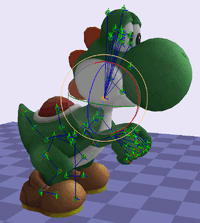Bones (also called nodes, joints, and similar names) are the mechanism for animating characters and other complex objects. Characters are generally modelled in a T-pose or similar position, and then "rigged" with bones to allow movement of body parts.
In the Super Smash Bros. series, bones have a secondary important purpose: All hitboxes and hurtboxes are attached to a certain bone so they move and rotate alongside their owner's animation. For example, putting a hitbox on a character's elbow bone, and offsetting it so it aligns with the character's hand, means it will always be in the same place as the hand without having to manually place it every frame. That said, many attacks are designed with manual placement instead, often to get specific hitbox shapes when the animation is inconvenient. Such hitboxes are usually attached to a bone that never moves during animations.
In Super Smash Bros. Brawl and earlier games, bones are generally coded in a character-specific order. Beginning in Super Smash Bros. 4, all the basic bones (head, arms, legs, etc.) are the same for everyone, and any unique bones (hair, capes, etc.) come afterward. This allows Kirby's Copy Ability to simply copy the code of the original character, rather than Kirby having to have his own independent version of every move.
Moveset swaps tend to reveal unusual properties of bones, as they apply the wrong animations to a character.
While most of this article refers to characters, every gameplay object has at least one bone, and most that aren't simple projectiles have several. For example, the movement of the platforms on the Lylat Cruise and Smashville stages are controlled via bone animation.
Special bones
Certain bones are used for gameplay purposes in addition to animation.
- The "top" or "root" bone is the top of the chain. It is the exact position of the character on the stage, and is the singular point that many interactions look at.
- The "translation" or "trans" bone is used when a character is to move during an animation, such as walking or using an up special move. Every frame of an animation, the character moves based on the distance and direction it would animate.
- The "have" bones are the attachment point of held items, and are generally in the character's hands.
- The "throw" bone is the attachment point of characters to each other during grabs and throws. It also serves other utility functions, such as the position of shields, tether grabs and carried heavy items.
List of common bones (Smash 4 onward)
The following list shows the bones common to every character since Smash 4, with their numerical index and internal codenames.
| Bone index | Bone name | Description | |
|---|---|---|---|
| Decimal | Hex | ||
| 0 | 0x0 | top | Root point (described above) |
| 1 | 0x1 | trans | Translation point (described above) |
| 2 | 0x2 | rot | Similar to top bone, but follows the character's rotation |
| 3 | 0x3 | hip | Hip |
| 4, 8 | 0x4, 0x8 | legl, legr | Upper legs |
| 5, 9 | 0x5, 0x9 | kneel, kneer | Lower legs |
| 6, 10 | 0x6, 0xA | footl, footr | Feet |
| 7, 11 | 0x7, 0xB | toel, toer | Toes |
| 12 | 0xC | waist | Waist |
| 13 | 0xD | bust | Bust |
| 14, 20 | 0xE, 0x14 | colonells, colonellm | Shoulders |
| 15, 21 | 0xF, 0x15 | shoulderl, shoulderr | Upper arms |
| 16, 22 | 0x10, 0x16 | arml, armr | Lower arms |
| 17, 23 | 0x11, 0x17 | handl, handr | Hands |
| 18 | 0x12 | neck | Neck |
| 19 | 0x13 | head | Head |
| 24, 25 | 0x18, 0x19 | havel, haver | Hand attachment points (described above) |
| 26 | 0x1A | throw | General attachment point (described above) |

